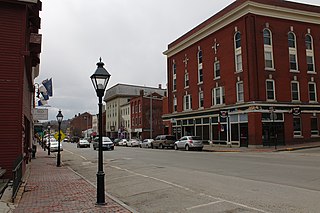
Hallowell is a city in Kennebec County, Maine, United States. The population was 2,570 at the 2020 census. Popular with tourists, Hallowell is noted for its culture and old architecture. Hallowell is included in the Augusta, Maine, micropolitan New England City and Town Area.
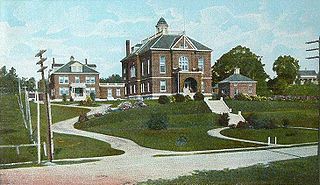
Paris is a town in and the county seat of Oxford County, Maine, United States. The population was 5,179 at the 2020 census. The census-designated place of South Paris is located within the town. Because the U.S. Post Office refers to the entire town as South Paris, the town as a whole is commonly referred to as South Paris. The main exception is the area known as Paris Hill, which is a scenic historic district popular with tourists. On May 30, 2019, the town declared itself to be a second amendment sanctuary.

Aretas Blood was an American businessman from Vermont. He played an important role in the manufacture of early American railroad steam locomotives.

The Maine State House in Augusta, Maine, is the state capitol of the State of Maine. The building was completed in 1832, one year after Augusta became the capital of Maine. Built using Maine granite, the State House was based on the design of the Massachusetts State House.

The Lewiston Public Library is a historic public Carnegie library at Park and Pine Street in Lewiston, Maine.

The Latham Confederate Monument in Hopkinsville, Kentucky's Riverside Cemetery, is a monument on the National Register of Historic Places.

The Peabody Institute Library is the public library serving Peabody, Massachusetts. It was established in 1852 by a bequest from philanthropist and Peabody native George Peabody, and now has its main facility at 82 Main Street, with the South Branch at 78 Lynn Street and West Branch at 603 Lowell Street. The main library is housed in a two-story brick building built in 1853 which is now listed on the National Register of Historic Places. The library is claimed to be the oldest public library in the United States to operate continuously from the same location.

The Rangeley Public Library is located at 7 Lake Street in Rangeley, Maine. The library is privately owned by the non-profit Rangeley Library Association, and is open to the general public. It is located in an architecturally distinguished Romanesque Revival building designed by New York City architect Ambrose Walker and built in 1909, with a major addition in 2002. The building was listed on the National Register of Historic Places in 1978.
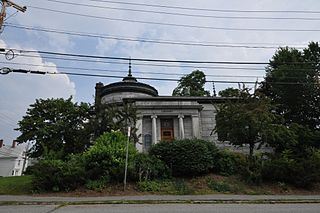
The Cutler Memorial Library building houses the public library of Farmington, Maine. It is located at 117 Academy Street, between the downtown area and the campus of the University of Maine at Farmington. Its building, dedicated to the memory of Nathan Cutler, was built in 1901-03 as the town's first dedicated library building, and was added to the National Register of Historic Places in 1973.

The Cary Library is the public library of Houlton, Maine, USA. It is located at 107 Main Street, in an architecturally distinguished building designed by John Calvin Stevens. The building was added to the National Register of Historic Places in 1987. The library opened on October 12, 1904.

The statue of John Aaron Rawlins, a United States Army general who served during the Civil War and later as Secretary of War, is a focal point of Rawlins Park, a small public park in Washington, D.C.'s Foggy Bottom neighborhood. It was installed in 1874, but relocated several times between 1880 and 1931. The statue was sculpted by French-American artist Joseph A. Bailly, whose best known work is the statue of George Washington in front of Independence Hall in Philadelphia.

The Charles M. Bailey Public Library is the public library serving Winthrop, Maine. It is located at 39 Bowdoin Street, near the town center. It was officially established by the town on November 4, 1916, and opened to the public on December 2, 1916. The library became a free library in 1970, and was added to the National Register of Historic Places in 1985. The original granite structure was designed by prominent Maine architect John Calvin Stevens, and his son John Howard Stevens. The 2015 addition was designed by Maine architect Philip M Locashio.
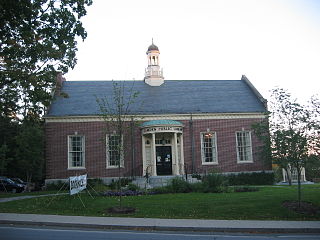
The Camden Public Library is the public library serving Camden, Maine, United States. It is a National Historic Landmark and is listed on the National Register of Historic Places.
Alexander Curtis Currier was an American architect and designer of cemetery monuments.

The Hallowell Historic District encompasses the historic 18th and 19th-century heart of Hallowell, Maine. The city developed as a major port on the Kennebec River, during which time its downtown and adjacent residential area were built up. Fully half of the area's more than 400 buildings were built before 1865. The district was listed on the National Register of Historic Places in 1970.
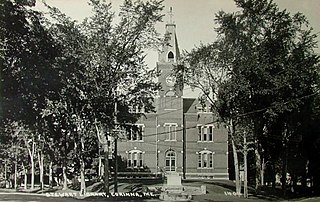
The Stewart Free Library is a historic municipal building at the junction of Nokomis and St. Albans Roads in Corinna, Maine. Built in 1895-98, it is an imposing Victorian brick building of unusual sophistication for a small rural community. It presently houses the town's library and municipal offices. It was listed on the National Register of Historic Places in 1974.

The Zadoc Long Free Library is the public library of Buckfield, Maine, United States. It is located at 5 Turner Street in a small wood-frame building designed by John Calvin Stevens and built in 1901. It was a gift to the town from Buckfield native John Davis Long in honor of his father Zadoc, and was the town's first library. The library was listed on the National Register of Historic Places in 1994.
The Vinalhaven Public Library is the public library serving the island community of Vinalhaven, Maine. It is located at 6 Carver Street in downtown Vinalhaven, in a small architecturally distinguished Prairie School building built in 1906 with financial support from Andrew Carnegie. The building was listed on the National Register of Historic Places in 1989.
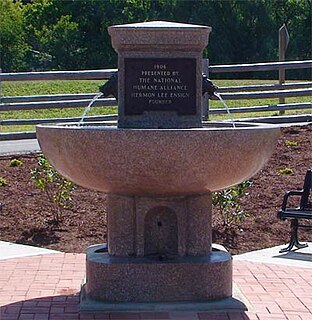
The National Humane Alliance fountains are a series of granite drinking fountains distributed by the National Humane Alliance, intended to provide fresh drinking water for horses, dogs, cats, and people. About 125 of the fountains were donated to cities throughout the United States and Mexico between 1902 and 1915. Most of the fountains have been removed from their original sites, usually in the center of busy intersections, but at least 70 of them are still publicly viewable. Two examples are listed on the National Register of Historic Places: one in Des Moines, Iowa and one in Albuquerque, New Mexico.

Emma Huntington Nason was an American poet, author, and musical composer. When only twelve years old, she began to write in verse. She devoted much time to literature, art and music, in each of which she excelled. Her works included, My Ancestors; Address and poem at the dedication of the Hallowell library, March 9, 1880 with historical sketch ..., 1880; Songs of the orient, 1892; The Tower, with Legends and Lyrics, 1895; Augusta centennial souvenir., 1897; Old colonial houses in Maine built prior to 1776, 1908; and Old Hallowell on the Kennebee, 1909.





















